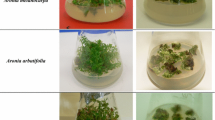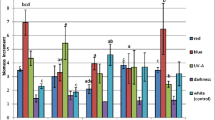Abstract
Phototropic stimulation of dark-grown hypocotyls of Arabidopsis thaliana increased a growth inhibitor in the wild-type but not in the non-phototropic nph3-101 mutant. From light-grown wild-type shoots the inhibitor was isolated and identified as indole-3-acetonitrile (IAN) from its 1H NMR spectrum. The content of endogenous IAN in the hypocotyls of wild-type and mutant unilaterally exposed to blue light was determined using a physicochemical assay. The IAN concentration (28 μM) in the phototropically stimulated wild-type hypocotyls was about three times larger than in the dark control. However, its content in the mutant hypocotyls did not change. IAN inhibited the hypocotyl growth of the nph3-101 to the same extent as in the wild-type at concentrations higher than 10 μM. These results suggest that IAN plays a role in the phototropism of Arabidopsis thaliana hypocotyls.
Similar content being viewed by others
References
Ahmad M., Jarillo J.A., Smirnova O. and Cashmore A.R. 1998. Cryptochrome blue-light photoreceptors of Arabidopsis implicated in phototropism. Nature 392:720–723.
Albagli O., Dhordain P., Deweindt C., Lecocq G. and Leprince D. 1995.The BTB/POZ domain:a new protein-protein interaction motif common to DNA-and actin-binding pro-teins. Cell Growth Differ. 6:1193–1198.
Aravind L. and Koonin E.V. 1999. Fold prediction and evolutionary analysis of the POZ domain:structural and evolutionary relationship with the potassium channel tetramerization domain. J.Mol.Biol. 285:1353–1361.
Briggs W.R., Beck C.F., Cashmore A.R., Christie J.M., Hughes J., Jarillo J.A., Kagawa T., Kanegae H., Liscum E., Nagatani A., Okada K., Salomon M., Rudiger W., Sakai T., Takano M., Wada M. and Watson J.C. 2001. The phototropin family of photoreceptors. Plant Cell 13:993–997.
Bruinsma J. and Hasegawa K. 1990. A new theory of photot-ropism -its regulation by a light-induced gradient of auxin-inhibiting substances. Physiol. Plant. 79:700–704.
Bruinsma J., Karssen C.M., Benschop M. and van Dort J.B. 1975. Hormonal regulation of phototropism in the light-grown sunflower seedlings, Helianthus annuus L.:immobility of endogenous indoleacetic acid and inhibition of hypocotyl growth by illuminated cotyledons. J. Exp. Botany 26:411–418.
Franssen J.M., Cooke S.A., Digby J. and Firn R.D. 1981. Measurements of differential growth causing phototropic curvature of coleoptiles and hypocotyls. Z. Pflanzenphysiol. 103:207–216.
Hasegawa K., Noguchi H., Tanoue C., Sando S., Takada M., Sakoda M. and Hashimoto T. 1987. Phototropism in hy-pocotyls of radish IV.Flank growth and lateral distribution of cis-and trans-raphanusanins in the first positive photo-tropic curvature. Plant Physiol. 85:379–382.
Hasegawa K. and Yamada K.1992. Even distribution of endogenous indole-3-acetic acid in phototropism of pea epi-cotyls. J. Plant Physiol. 139: 455–459.
Hasegawa T., Yamada K., Kosemura S., Yamamura S. and Hasegawa K. 2000. Phototropic stimulation induces the conversion of glucosinolate to phototropism-regulating sub-stances of radish hypocotyls. Phytochemistry 54:275–279.
Hasegawa T., Yamada K., Shigemori H., Miyamoto K., Ueda J. and Hasegawa K. 2004. Isolation and identification of phototropism-regulating substances benzoxazinoids from maize coleoptiles. Heterocycles (in press).
Hoshi-Sakoda M., Usui K., Ishizuka K., Kosemura S., Yamamura S. and Hasegawa K. 1994. Structure-activity relationships of benzoxazolinones with respect to auxin-in-duced growth and auxin-binding protein. Phytochemistry 37: 297–300.
Kosemura S., Niwa K., Emori H., Yokotani-Tomita K., Ha-segawa K. and Yamamura S. 1997. Light-induced auxin-inhibiting substance from cabbage (Brassica oleacea L.) shoots. Tetrahedron Lett. 38:8327–8330.
Liscum E. and Briggs W.R. 1995. Mutations in the NPH1 locus of Arabidopsis disrupt the perception of phototropic stimuli. Plant Cell 7:473–485.
Lupas A.1996. Coiled coils:new structure and new functions. Trends Biochem. Sci. 21:375–382.
Okada K. and Shimura Y.1992. Mutational analysis of root gravitropism and phototropism of Arabidopsis thaliana seedlings. Aust. J. Plant Physiol. 19:439–448.
Sakai T., Wada M., Ishiguro S. and Okada K. 2000. RPT2:a signal transducer of the phototropic response in Arabidopsis. Plant Cell 12:225–236.
Sakoda M., Matsuoka T., Sando S. and Hasegawa K. 1988. Phototropism in hypocotyls of radish V.Lateral distribution of cis-and trans-raphanusanins and raphanusamide in vari-ous phototropisms induced by unilateral broad blue light. J. Plant Physiol. 133:110–112.
Yamamura S. and Hasegawa K. 2001. Chemistry and biology of phototropism-regulating substances in higher plants. Chemical Record 1:362–372.
Yokotani-Tomita K., Kato J., Yamada K., Kosemura S., Yamamura S., Bruinsma J. and Hasegawa K. 1999. 8-Epix-anthatin, a light-induced growth inhibitor, mediates the phototropic curvature in sunflower (Helianthus annuus L.) hypocotyls. Physiol. Plant. 106:326–330.
Author information
Authors and Affiliations
Rights and permissions
About this article
Cite this article
Hasegawa, T., Yamada, K., Shigemori, H. et al. Isolation and identification of blue light-induced growth inhibitor from light-grown Arabidopsis shoots. Plant Growth Regulation 44, 81–86 (2004). https://doi.org/10.1007/s10725-004-2603-6
Issue Date:
DOI: https://doi.org/10.1007/s10725-004-2603-6




